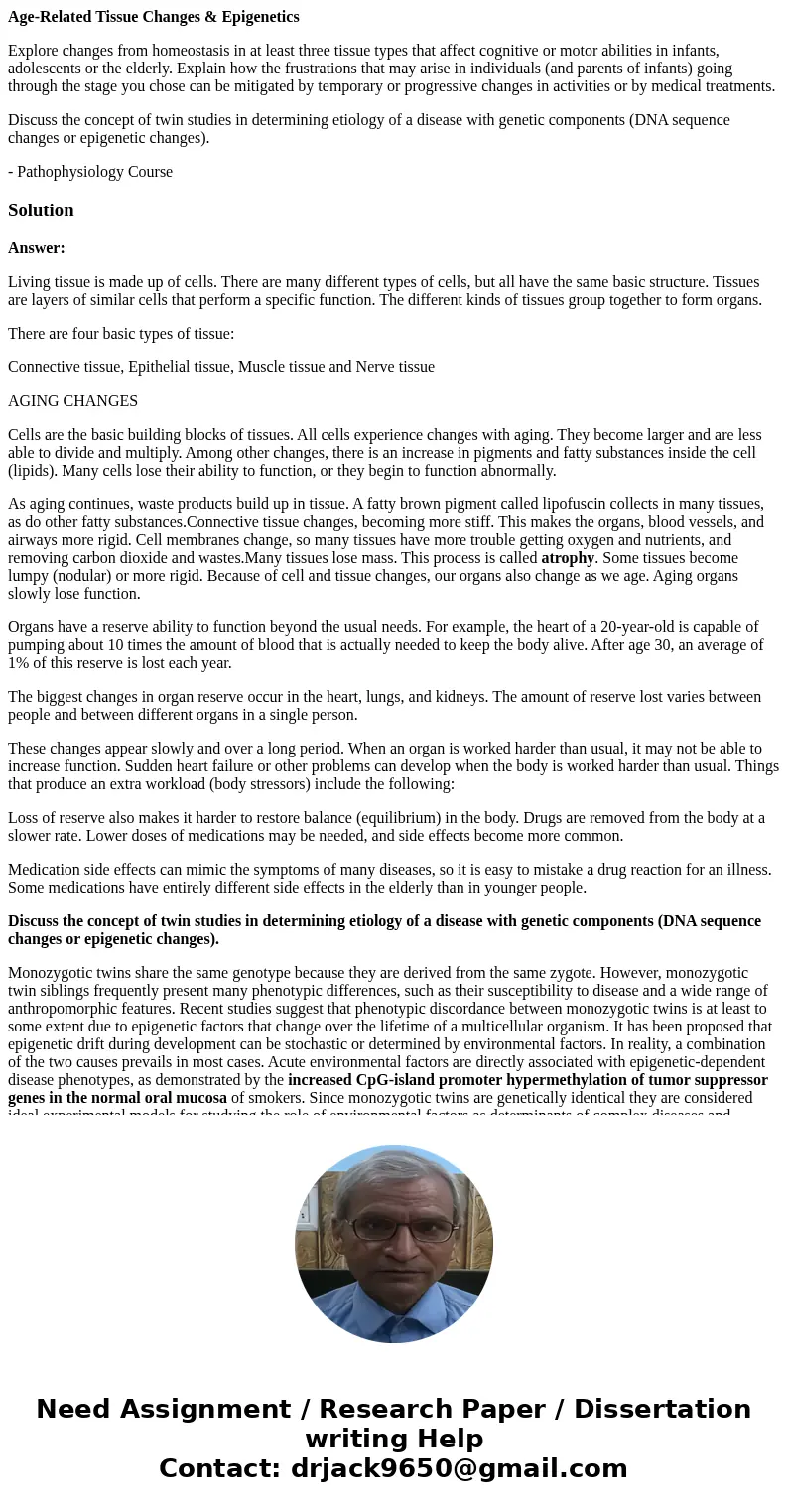AgeRelated Tissue Changes Epigenetics Explore changes from
Age-Related Tissue Changes & Epigenetics
Explore changes from homeostasis in at least three tissue types that affect cognitive or motor abilities in infants, adolescents or the elderly. Explain how the frustrations that may arise in individuals (and parents of infants) going through the stage you chose can be mitigated by temporary or progressive changes in activities or by medical treatments.
Discuss the concept of twin studies in determining etiology of a disease with genetic components (DNA sequence changes or epigenetic changes).
- Pathophysiology Course
Solution
Answer:
Living tissue is made up of cells. There are many different types of cells, but all have the same basic structure. Tissues are layers of similar cells that perform a specific function. The different kinds of tissues group together to form organs.
There are four basic types of tissue:
Connective tissue, Epithelial tissue, Muscle tissue and Nerve tissue
AGING CHANGES
Cells are the basic building blocks of tissues. All cells experience changes with aging. They become larger and are less able to divide and multiply. Among other changes, there is an increase in pigments and fatty substances inside the cell (lipids). Many cells lose their ability to function, or they begin to function abnormally.
As aging continues, waste products build up in tissue. A fatty brown pigment called lipofuscin collects in many tissues, as do other fatty substances.Connective tissue changes, becoming more stiff. This makes the organs, blood vessels, and airways more rigid. Cell membranes change, so many tissues have more trouble getting oxygen and nutrients, and removing carbon dioxide and wastes.Many tissues lose mass. This process is called atrophy. Some tissues become lumpy (nodular) or more rigid. Because of cell and tissue changes, our organs also change as we age. Aging organs slowly lose function.
Organs have a reserve ability to function beyond the usual needs. For example, the heart of a 20-year-old is capable of pumping about 10 times the amount of blood that is actually needed to keep the body alive. After age 30, an average of 1% of this reserve is lost each year.
The biggest changes in organ reserve occur in the heart, lungs, and kidneys. The amount of reserve lost varies between people and between different organs in a single person.
These changes appear slowly and over a long period. When an organ is worked harder than usual, it may not be able to increase function. Sudden heart failure or other problems can develop when the body is worked harder than usual. Things that produce an extra workload (body stressors) include the following:
Loss of reserve also makes it harder to restore balance (equilibrium) in the body. Drugs are removed from the body at a slower rate. Lower doses of medications may be needed, and side effects become more common.
Medication side effects can mimic the symptoms of many diseases, so it is easy to mistake a drug reaction for an illness. Some medications have entirely different side effects in the elderly than in younger people.
Discuss the concept of twin studies in determining etiology of a disease with genetic components (DNA sequence changes or epigenetic changes).
Monozygotic twins share the same genotype because they are derived from the same zygote. However, monozygotic twin siblings frequently present many phenotypic differences, such as their susceptibility to disease and a wide range of anthropomorphic features. Recent studies suggest that phenotypic discordance between monozygotic twins is at least to some extent due to epigenetic factors that change over the lifetime of a multicellular organism. It has been proposed that epigenetic drift during development can be stochastic or determined by environmental factors. In reality, a combination of the two causes prevails in most cases. Acute environmental factors are directly associated with epigenetic-dependent disease phenotypes, as demonstrated by the increased CpG-island promoter hypermethylation of tumor suppressor genes in the normal oral mucosa of smokers. Since monozygotic twins are genetically identical they are considered ideal experimental models for studying the role of environmental factors as determinants of complex diseases and phenotypes.

 Homework Sourse
Homework Sourse